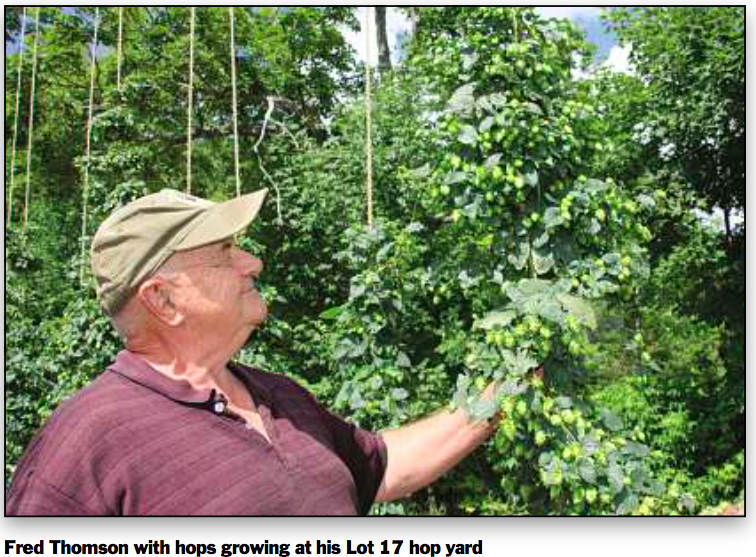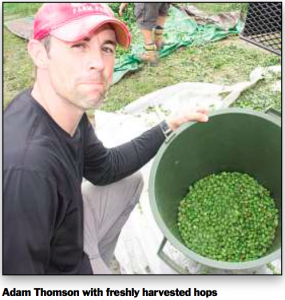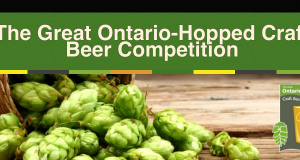OHGA member, Lot 17 hop yard, featured in a recent issue of the Ontario Farmer.
BY SUZANNE ATKINSON
The writer farms near Warkworth zan@xplornet.com
Trent Hills – By now fresh craft beer made from Ontario hops harvested this year could be hitting the shelves of your favorite local watering hole.
If you’re in the Ottawa area, some will be made from hops harvested on a warm September day, at a yard here just east of Campbellford, not far from the banks of the Trent River.
Here at Lot 17 on this first decent day of September two brewers, two hops growers and assorted family members have gathered. The day’s job? The harvesting of 460 plus bines grown and tended lovingly by Fred and Loraine Thomson, their son Adam and his wife Stephanie.
Lot 17 is small as hops yards go; but the work keeps retired Agricore rep Fred Thomson thinking, experimenting and innovating. Since 2011 he and son Adam have been growing and expanding this yard, experimenting with everything from varieties to soil treatment, bine management to pest control.
“There’s a certain amount of ‘art,’ to growing hops,” Thomson says.
“One of my key learnings this year is how to pick the right time to prune them, and how to prune them,” he says explaining that the bine should reach the 16’ top of the coir by the summer equinox.
“Ours didn’t do that and that was my fault,” he says, admitting to being a little over aggressive with the knife.
“They didn’t like that.”
“Hops, because it’s a re-emerging crop, there are a lot of things to relearn,” he says, explaining that under ideal conditions they can grow 6” to 1’ a day.
Hops, Thomson says, are resilient; they over-winter well. But they are susceptible to all manner of disease and insect which can ruin the fragile hop cones, and as that cone is developing, “they are heavy drinkers.”
Most recently though the Thomsons’s journey to learn more about the business of hops saw them invite Rob Brennan in for the harvest.
Brennan, of Old 4th Hop Yard at Williamstown, has recently imported the province’s first hops.harvester hops harvester; new technology which takes most of the manual labour, out of this job.
HopsHarvester.com’s hop harvester works very much like a stationary combine. Bines laden (hopefully) with mature hops are fed on a conveyor into the back of the machine, through a patent-pending rotatory bar. The heavier wet hops fall onto a conveyor belt and are filtered out the side to a container while the lighter-weight stripped vines and leaves are segregated on an upper conveyor and belted out the front where they are gathered for later destruction.
“If you’re going to grow at all,” says Brennan, “eventually you’re going to have to mechanize.”
Because as hops growers the province over have learned, one hops harvesting party is enough. “Nobody has that many friends,” says Brennan.
Hops growing is an emerging industry here in Ontario. Approximately 35 growers are ramping up production with Ontario’s hop acreage now at about 60 acres. The province still imports about 550 kg annually. That’s $7 million of product which could be grown in Ontario, says OMAFRA’s latest report on the crop.
Still, the province’s acreage has gone up by 300 per cent since 2009, with the Thomsons hoping to quadruple the size of their yard in the next four years, depending on Adam’s military postings.
“It’s plenty for me to handle in the day today by myself.”
Terroir, Thomson, says is important as Lot 17 has worked with Dominion City Brewery in developing a special craft brew.
“If you can put up the quality, if you can put up the product… in a format the brewer can use, there is no end of demand for this product. We aren’t even scratching the surface,” he says.
“In my 40 plus years of being involved in agriculture I don’t think I’ve ever seen a crop that has the potential this one has.”
Is it lucrative?
“I think so. Smart producers will establish relationships with craft brewers because you need to know what the craft brewer is looking for….”
Good hops, he says, could be worth $15-$20 per lbs. With “reasonable management,” he says, a grower should be able to produce 1,000 lbs. of dry hops per acre.
Brennan, an out of work television cameraman, jumped in to the industry after he and his wife toured a brewery and learned of the province’s perennial shortage of domestic hops.
“I sent them an email and said I’ll grow hops for you,” he told Ontario Farmer. The reply was that his was the 50th offer; and no one had yet followed through.
“I sent them an email and said I’ll grow hops for you,” he told Ontario Farmer. The reply was that his was the 50th offer; and no one had yet followed through. “I took that as a challenge.”
With eight acres of hops in cultivation, Brennan knows that mechanization is paramount. But he says, most Ontarians were trying to resurrect old machines which Europe had mothballed in the 70s and 80s.
The price plus the idea of old technology held no interest for Brennan who set out to design his own machine, and came instead upon the hop harvester being produced at Rochester, New York.
“John, the manufacturer had solved a lot of the problems I was having and I couldn’t build one cheaper than he was selling his for,” Brennan says.
Today Scott Denyer, Dominion City Brewery’s assistant has come. He points out the tiny, yellow lupulin glans in each hop, explaining that is the gold nugget; the pearl of today’s harvest. “Hops are the spice of the beer;” he says, “the salt and pepper of it.”
Most Ontario-produced craft beer uses pelletized hop, Thomson says, simply because fresh crop is not available.
Also on hand is John Graham of Campbellford’s 25 year old Church-Key Brewing Co., whom Thomson expects in the future Lot 17 could also supply.
Adam handles the social media stuff; the marketing, while Fred studies emerging trends, attends field days, experiments with nitrogen and constantly is on the watch for disease and bug damage.
With other crops growing on his ancestral farm and semi-retirement to enjoy Thomson isn’t planning to fill the Ontario market himself anytime soon.
And on this beautiful September day with the hops coming off mostly clean, there’s always a little hand- stripping to do, and time for a break to savour another Dominion City Brewery offering.
How was last year’s ‘Land is Strong?” A smile crosses Thomson’s face. “I did try it,” he says. “It was quite acceptable.”
To see them in there original format, please download the attached .pdf files.
FARMB_015_1006.pdf
 Ontario Hop Growers' Association The OHGA is a not-for-profit association of hop growers, families and enthusiasts who are interested in supporting the growth of the hop industry in Ontario.
Ontario Hop Growers' Association The OHGA is a not-for-profit association of hop growers, families and enthusiasts who are interested in supporting the growth of the hop industry in Ontario.



